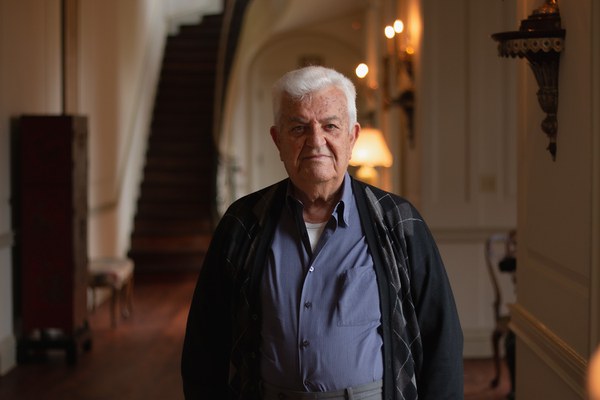Evangelos Chrysos, emeritus professor of Byzantine history at the University of Athens, was a visiting scholar in Byzantine Studies in spring 2019. His recent talk, “A Blitz War of Languages: Greek and Latin in the Confrontation Between Pope Nicholas and Patriarch Photius,” addressed the ninth-century controversy known as the Photian Schism.
Q&A with Evangelos Chrysos
How does a forgery of church documents provide context for your research?
In the middle of the ninth century, probably at the French monastery Corbie Abbey, very intelligent monks decided to change the basics of church life by replacing existent rules—the canon law—with new material. They forged documents in the name of ancient Roman popes so the rulings would appear obligatory for the receiver.
The documents, called Pseudo-Isidorian Decretals, make a huge volume: the largest corpus of forgeries in world history. One forgery is a supposed decision by Emperor Constantine in the beginning of the fourth century to give up the western provinces of the Roman empire, and all his palaces and fortresses there, to the bishop of Rome and make his new seat of power in the east.
Everybody believed these documents. They were put into larger canonical law codes. For seven centuries, they were the decisive texts according to which people moved and behaved toward each other. There is good reason to believe Pope Nicholas I was the first to apply these documents to his own policies.
But the decretals were so complicated that only scholars could read and use them. Pope Nicholas had an incredibly capable scholar next to him named Anastasius, who later became bibliothecarius—chief of the pope’s library. Anastasius was tremendously intelligent and erudite, one of very few in the west at that time capable of reading and translating Greek texts. He must have influenced and persuaded the pope to make use of the decretals in his correspondence with the east.
Which controversial correspondence have you investigated during your time here?
At issue between east and west was the need of the pope—in the name of these new decretals—to control the other churches, including the church of Constantinople. The pope would write to Emperor Michael III in Constantinople or to Patriarch Photius, a well-known scholar who was head of the government and then asked to become patriarch (bishop) of Constantinople.
I started looking at the correspondence of confrontation because the pope refused to accept as canonical the ordination of Photius. In 865, Emperor Michael wrote, apparently, a rude letter to the pope. I say apparently because the text is not preserved. What is preserved is the answer written by the pope. I’m sure it was written by Anastasius Bibliothecarius and signed by the pope. Anastasius was the ghostwriter.
In his letter of response, the pope accuses the emperor of ridiculing the Latin language as barbaric and Gothic. Barbaric means that those who wrote Latin were not educated enough to write in fine, high Latin. Gothic was then the language of non-Roman citizens who used Latin officially but more or less Gothic or Theodisca (German) words in their vernacular speech.
This started a huge new confrontation over which was the right language—how good Latin was to be the authoritative language in the whole empire and the whole church in the west. Simultaneous conflict over missionizing the Slavs in central Europe brought a higher level of controversy to the issue of the Latin language. Missionaries from the German kingdom insisted that while the vernacular Slavic language could be used for sermons, the liturgy had to be read in Latin. Meanwhile, Cyril and Methodius from the east came to what today is Czechia and produced, for the first time, an alphabet of the Slavic language, into which they translated both the Bible and the mass text, so the mass could be read in the vernacular.
For some years, Rome said the distinction between east and west was no longer geographical but linguistic—the west was identified with those who spoke Latin. It was a call for a clash of cultures. Identifying Western Christendom as the Christendom of the Latin language upset the whole balance of relations. It was an incident in the long history of medieval disputes and controversies, where for the first time, in my eyes, language was a weapon in the battles.
What has made working on this topic at Dumbarton Oaks especially meaningful?
My history with Dumbarton Oaks is a history of love. I came in the early ’70s for the first time as a young scholar, and I was received very warmly. Dumbarton Oaks is a mecca for the Byzantinist. During my current stay, I decided to study the missions to the Slavs because of someone I met at my first visit here: Father Francis Dvornik, a Roman Catholic priest and scholar from Czechia, who wrote very important books on these topics. Now, 50 years later, I can touch on one or two of the topics we discussed then, in memory of Francis Dvornik.
Julia Ostmann is postgraduate writing and reporting fellow at Dumbarton Oaks. Photo by Elizabeth Muñoz Huber, postgraduate digital media fellow.

